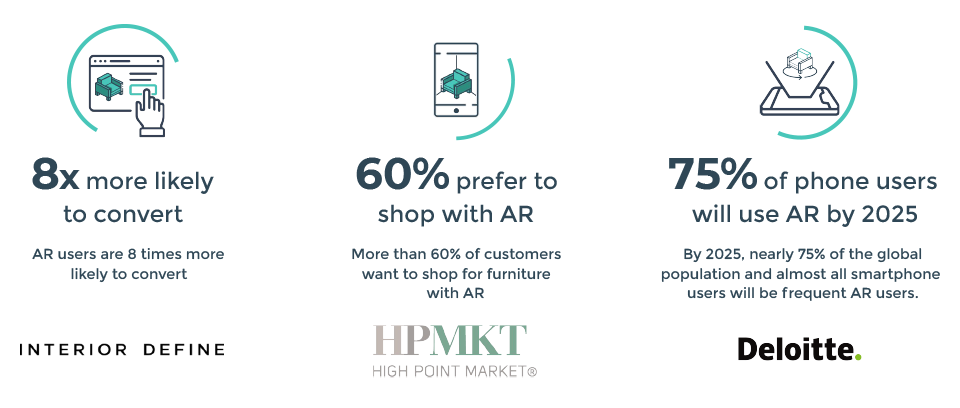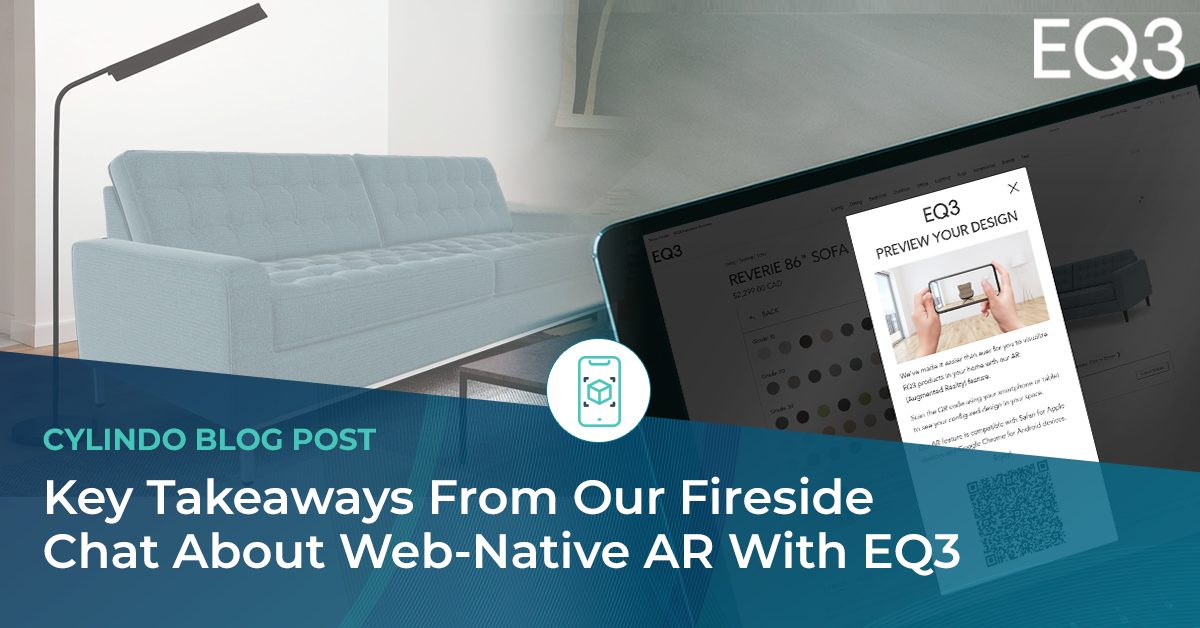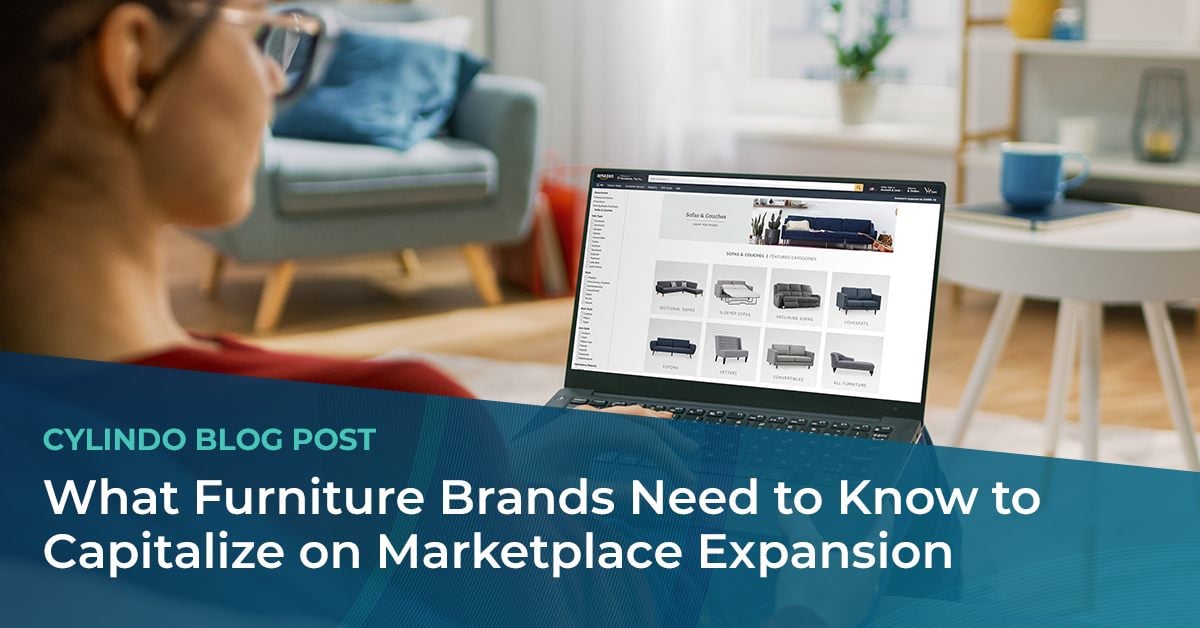In our latest Fireside Chat, Dan Gange, Director of E-Commerce at EQ3, and Malina Andre, Enterprise Customer Success Manager at Cylindo, shared their inside knowledge on web-native augmented reality (AR) and a post-COVID-19 peek into the world of furniture retail. Here you can read a short summary of the main concepts and questions they discussed.
The new chapter of furniture shopping
1. Customer behavior has changed
Customer behavior has shifted significantly in these last few years. In the pre-COVID-19 world, there was an expected cycle of customers' actions, how they were spending, and how they were engaging with technology. But as we slowly enter the post-COVID-19 period, there is no clear pattern of how customers are shopping.
Today’s customer journey is more dynamic. As a result, furniture retailers need to step up their game and meet customers at every touchpoint.
"Pre-COVID, the focus was on two worlds: e-commerce and the in-store world. On the EQ3 side during COVID-19, we saw how dynamic that experience was and how significant a role the stores played in closing those sales and reducing people's fear, uncertainty, and doubt.
In the post-COVID world, we see an expansion of the buyer journey, and more and more customers are relying on the e-commerce experience to make those purchases or at least to get to the end of making that purchase. And from a numbers perspective, we're seeing a significant decrease in the number of store visits required to make a purchase, so people are showing up in stores pretty much knowing what they are going to buy." - Dan Gange, Director of E-Commerce at EQ3
2. The impact of AR across different industries
The furniture industry is one of the first product categories where retailers found that AR would mark a high success. According to Deloitte, furniture is in the optimal place for taking action with augmented reality. This is due to the possibility for high standardization of furniture products, and increasing customization opportunities. As a result, augmented reality has demonstrated a positive return on investment (ROI) and potential for widespread adoption.

3. Bridging the online-offline gap
When customers are in the consideration phase of the purchasing process, they compare and analyze products. To do this, a few years ago, they were going to different stores to check out the products in person. Today, thanks to the benefits of AR, consumers can visualize how the furniture will look in their homes — something that they were unable to do in stores.
After choosing which product best fits their space with AR, buyers can finish the purchasing process online or visit a store. Nowadays, consumers can rely on online shopping, pre-build their carts, and then go to a store to finish their purchase. Ordering swatches and using AR to see the product before buying closes the online-offline gap. It won't be long until augmented reality becomes an inevitable part of the furniture buyer's journey.
4. AR helps customers make a better purchasing decision
Furniture businesses can leverage augmented reality to offer better online and in-store shopping experiences and help customers make better purchasing decisions. One of the ways to evaluate this is by surveying customers, thus gaining information about their contentment with the technology.
EQ3 regularly conducts customer surveys to check customer satisfaction and collects data about what they should change. The feedback said that AR has helped its customers while shopping. This shows that consumers who use AR get a better sense of what they are buying and make smarter purchasing decisions.
"We introduced a new product (with phenomenal in-store sales) that was not selling online. When we turned Cylindo on, in the first weekend only, we saw more sales than what we had seen in the few months that the product had been available in store. The point in that analogy is that the ability to understand precisely what customers are buying enables them to complete that purchase." - Dan Gange, Director of E-Commerce at EQ3
5. AR reduces product return rates
When customers get an exact image of what they are buying before ordering it, their satisfaction level will be higher when they receive the product. Augmented reality sets the right expectations and prevents product returns.
Thanks to augmented reality, EQ3 has witnessed reduced upholstered furniture returns.
"After implementing augmented reality, we saw a fairly significant reduction in returns on upholstered furniture. When we look at the product returns data, we’re seeing fewer people unhappy about their decisions. When they make product returns, there’s something wrong, like a broken, damaged product due to the shipping process, as opposed to a dislike of the product." - Dan Gange, Director of E-Commerce at EQ3
Web-native vs. AR apps - which one is better and why?
Furniture companies that decide to adopt augmented reality will have to choose whether they will use a mobile application or a web-native AR feature. To make the right decision, they first need to understand the differences between both options.
For a comprehensive breakdown of the ROI and friction points of both platforms, read our guide: Augmented Reality (AR) in Furniture E-commerce.
When choosing the right technology for your business, you should focus on what brings you tangible ROI and has a high adoption rate.
When thinking about AR applications, you need to consider the customer experience. Don't forget that customers will have to download an app to experience your augmented reality option. With web-native AR, customers can utilize the augmented reality option without downloading a mobile app. This option enables customers to see 3D models of the products they want right from their browsers.
“When we think about who is browsing on desktop vs. mobile, let’s say that 50% are desktop users and 50% are mobile. If I’m only showing it to 50% on mobile, that means half my user base is exposed. And in the same way, with an app, that would mean that you would have to get everybody into the app. If your use case in the app is 20% of your total users, 80% of your users are not going to see the AR. And to get a better experience and increase those conversion rates, you would want to show it to everybody. From a numbers perspective, it doesn’t make sense to me to have an app.” - Dan Gange, Director of E-Commerce at EQ3

How EQ3 is further leveraging Cylindo’s AR QR code
After implementing web-native AR on its product pages, EQ3 started thinking about creating a good user experience for customers browsing from their desktops. They had in mind that customers are more serious when purchasing on desktop as opposed to when buying from their smartphones.
EQ3 quickly realized that the easiest way to get people to use AR was by enabling them to see the product from their browsers, regardless of whether they are using mobile or desktop. Their idea was to use a QR code that would be generated on-site for mobile users and would pop up for desktop users, enabling them to get that AR experience and move down the funnel. So, they decided to implement an AR QR code on the product pages, thus making sure that all of their users can see the products in augmented reality before finalizing the purchasing process.
"Customers are more serious when they are purchasing on desktop as opposed to their phones. So when we see the QR code on the desktop, we're also exposing AR to people that are much closer to the purchase. Whereas, with the phones, customers are probably in the browsing and experimenting phase, compared to that purchasing phase. Augmented reality is more important later down the funnel." - Dan Gange, Director of E-Commerce at EQ3
After EQ3 implemented the AR QR code for desktop users, they found out that a shopper who uses AR has a 112% higher conversion rate than someone who doesn't use AR. What's more, they also realized that AR users have two times higher AOV.
Are you curious to learn more about how web-native AR helped EQ3 reinvent online furniture shopping? Watch the entire Fireside Chat with Dan Gange.
.jpg)



